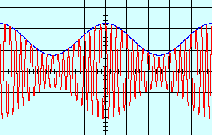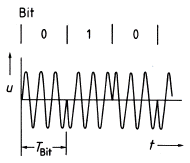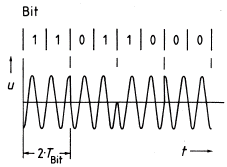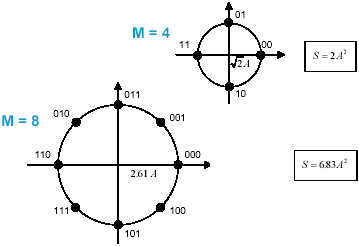[ASICs] [Chip Typen] [Chip Aufbau] [Entwicklung] [Schnittstellen] [Glossar]
[Buffer Types] [Interfaces] [Networks] [IEEE 802 Networks] [Data Lines] [Protocols] [Organazations]
[Line Codes] [Multiplexing] [Modulation] [Line Rates] [Encryption]
 Modulation
Modulation
The following page gives a rough overview about several modulation techniques. The basics of modulation is to take a message bearing signal like an audio signal and superimpose it upon a carrier signal for transmission. For ease of transmission such carrier signals use generally high frequencies:
- For easy propagation as electromagnetic waves with low loss and low dispersion
- Simultaneous transmission without interference from other signals
- Enables the construction of small antennas (a fraction, usually a quarter of the wavelength)
- Enables the multiplexing (combining) multiple signals for transmission at the same time over the same carrier
In general the four different modulation schemes amplitude, frequency, phase and code modulation are possible. Well known examples of high frequency carrier signals are:
- AM radio is 550-1600 KHz
- FM radio is 88 MHz-108 MHz
- TV is 52-88 MHz (channels 1-6), 174-216 MHz (channels 7-12) and 470-900 MHz (UHF)
- microwave and satellite signals are of the order of several GHz
- infra red fiber optic signals are of the order of 200-300 THz.
The selection of the modulation scheme is done according to power and bandwidth efficiency and the channel capacity. The power efficiency is a measure of how much signal power should be increased to achieve a particular BER (Bit Error Rate) for a given modulation scheme. Bandwidth efficiency is the ability to accommodate data within a limited bandwidth of a channel. Its also a tradeoff between data rate and pulse width.
The classical analog modulation schemes are based on the continuous change of sinusodial signal carrier. Here the modulation can plays with one of 3 parameters: Change in frequency, amplitude or signal phase. Modern digital modulation schemes have already been developed and will replace the classical more and more.
Pulse Modulation Schemes
ADPCM Adaptive Differential Pulse Code Modulation
PAM Pulse Amplitude Modulation
PCM Pulse Code Modulation
PDM Pulse Duration Modulation
PFM Pulse Frequency Modulation
PPM Pulse Position Modulation
PSK Phase Shift Keying
PTM Pulse Time Modulation
PWM Pulse Width Modulation
ASK Amplitude Shift Keying
BPSK Binary Phase Shift Keying
FSK Frequency Shift Keying
QPSK Quadrature Phase Shift Keying
QAM Quadrature Amplitude Modulation
Other specified Quadrature Modulation (QM) schemes are:
- QAM Quantized Amplitude Modulation
- QFM Quantized Frequency Modulation
- QPAM Quadrature Phase and Amplitude Modulation
- QPAM Quantized Pulse Amplitude Modulation
- QPM Quantized Phase Modulation
- QPPM Quantized Pulse Position Modulation
- QSAM Quadrature Sideband Amplitude Modulation
- QUAM Quantized Amplitude Modulation
![]()
ADPCM Adaptive Differential Pulse Code Modulation; G.726
ADPCM is a technique defined by the International Telecommunication Union (ITU) for converting sound or analog information to binary information by taking frequent samples of the sound and expressing the
value of the sampled sound modulation in binary terms. This produces a lower bit rate and is sometimes used to effectively compress a voice signal, allowing both voice and digital data to be sent where only one
would normally be sent. ADPCM is used to send sound on fiber-optic long-distance lines as well as to store sound along with text, images, and code on a CD-ROM. It is also used in digital cordless
telephones, radio/wireless local loop and pair-gain.
ADPCM is a variation of pulse code modulation (PCM) that only sends the difference between two
adjacent samples. This produces a lower bit rate and is used to effectively compress a voice signal, allowing more voice channels or both, voice and digital data, to be sent within a 32k-kbit/s digital channel.
3 or 4 bits are used to describe each sample, which represents the difference between two adjacent samples. Sample rate is 8000 samples/second.
G.726 provides an outline description of the ADPCM transcoding algorithm including ADPCM encoding and decoding algorithms respectively. The coding scale can be dynamically changed to compensate for
amplitude and frequency variations.
Pulse Modulation Schemes
Pulse modulation schemes incorporate the basic idea to use the carrier signal as a pulse train. Different
choices of pulse formats are possible and have different aspects in terms of energy and spectral content consumption. Examples of pulse formats are square pulses, raised cosine pulses or sync function
(Nyquist) pulses. The characteristics of the pulse train that can be varied are:
- Pulse Amplitude
- Pulse Width
- Position of leading edge
Modulation schemes varying amplitude and width are called Pulse Amplitude Modulation (PAM) and Pulse Width Modulation (PWM) respectively.
Note that this basic scheme can be made more sophisticated by using several amplitude levels, for example grouping signal bits into groups of 2, i.e. 00, 01, 10 and 11 and have four different amplitude
levels for each of these groups. This scheme is known as Quadrature Pulse Amplitude Modulation (QPAM or QAM).
PAM Pulse Amplitude Modulation
Pulse Amplitude Modulation refers to a method of carrying information on a train of pulses, the
information being encoded in the amplitude of the pulses.
PCM Pulse Code Modulation
PCM is a general scheme for transmitting analog data in a digital and binary way, independent of the
complexity of the analog waveform. With PCM all forms of analog data like video, voice, music and telemetry can be transferred.
To obtain PCM from an analog waveform at the source (transmitter), the analog signal amplitude is sampled at regular time intervals. The sampling rate (number of samples per second), is several times the
maximum frequency of the analog waveform. The amplitude of the analog signal at each sample is rounded off to the nearest binary level (quantization). The number of levels is always a power of 2 (4, 8,
16, 32, 64, ...). These numbers can be represented by two, three, four, five, six or more binary digits (bits) respectively.
At the destination (receiver), a pulse code demodulator converts the binary numbers back into pulses having the same quantum levels as those in the modulator. These pulses are further processed to restore
the original analog waveform.
PDM Pulse Duration Modulation
PDM is a method of pulse modulation in which the duration of a the pulse train is used to transfer the
binary signal information.
PFM Pulse Frequency Modulation
PFM is a method of pulse modulation in which the modulating wave is used to frequency modulate a
pulse-generating circuit. For example, the pulse rate may be 8000 pulses per second (pps) when the signal voltage is 0. The pulse rate may step up to 9000 pps for maximum positive signal voltage, and
down to 7000 pps for maximum negative signal voltage. This method of modulation is not used extensively because of complicated PFM generation circuitry. It requires a stable oscillator that is
frequency modulated to drive a pulse generator.
PPM Pulse Position Modulation
The amplitude and width of the pulse is kept constant in the system. The position of each pulse, in relation
to the position of a recurrent reference pulse, is varied by each instantaneous sampled value of the modulating wave. PPM has the advantage of requiring constant transmitter power since the pulses are of
constant amplitude and duration. It is widely used but has the big disadvantage that it needs a synchronization between transmitter and receiver.
PTM Pulse Time Modulation
The Time characteristics of pulses may also be modulated with intelligence information. Two time
characteristics may be affected, the time duration of the pulses and the occurrence of the pulses. Thus PTM can be differentiated into the following 4 modulation sub-schemes:
- PDM Pulse Duration Modulation
- PPM Pulse Position Modulation
- PFM Pulse Frequency Modulation
- PWM Pulse Width Modulation
PWM Pulse Width Modulation
Pulse Width Modulation refers to a method of carrying information on a train of pulses, the information
being encoded in the width of the pulses.
In applications to motion control, it is not exactly information we are encoding, but a method of controlling power in motors without (significant) loss.
There are several schemes to accomplish this technique. One is to switch voltage on and off, and let the current recirculate through diodes when the transistors have switched off. Another technique is to switch
voltage polarity back and forth with a full-bridge switch arrangement, with 4 transistors. This technique may have better linearity, since it can go right down to an effective 0% duty cycle by having the positive
and negative voltage periods precisely equal. On/Off techniques may have trouble going down extremely close to 0% duty cycles, and may jitter between minimum duty cycles of positive and negative polarity.
In battery systems PWM is the most effective way to achieve a constant voltage for battery charging by switching the system controller's power devices on and off.
The generation of exact working PWM circuitry is complicated, but it is extremely conceptually important since there is good reason to believe that neurons transmit information using PWM spike trains.
ASK Amplitude Shift Keying
ASK is a scheme according to the old telegraph key. The transmission of the binary bit stream is done by
switching the carrier signal on/off according to 1/0 bits.
BPSK Binary Phase Shift Keying
BPSK shifts the phase of the carrier signal by 0 or by 180 degrees
depending upon the bits to be transferred. This scheme is simple to implement, but it's inefficient in terms of using the available bandwidth. It is very robust, which is the reason that BPSK is extensively used in
satellite communication systems.
FSK Frequency Shift Keying
FSK is the frequency modulation of a carrier. For Simplex or Half Duplex operation, a single carrier
(1170 Hz) is used - communication can only be transmitted in one direction at a time. A Mark or 1 is represented by 1270 Hz, and a Space or 0 is represented by 1070 Hz.
For Full Duplex (simultaneous data communication in both directions), the upper bandwidth of the Voice Channel is utilized. Another carrier is added at 2125 Hz. A Mark or 1 is represented by 2225 Hz, and a
Space or 0 is represented by 2025 Hz. The originating modem uses the lower carrier (1170 Hz) and the answer modem uses the upper carrier (2125 Hz).
QPSK Quadrature Phase Shift Keying
Quadrature Phase Shift Keying employs shifting the phase of the
carrier at a 600 baud rate plus an encoding technique. QPSK is used in Bell 212A-compatible modems and V.22 - both are 1200 bps Full Duplex standards. The originate modem transmits
at 1200 Hz, and receives on 2400 Hz. The answer modem receives on 1200 Hz, and transmits on 2400 Hz. The digital information is encoded using 4 (Quad) level differe ntial PSK at 600 baud, 00 for 90 degrees, 01 for 0 degrees, 10 for 180 degrees and 11 for 270 degrees.
ntial PSK at 600 baud, 00 for 90 degrees, 01 for 0 degrees, 10 for 180 degrees and 11 for 270 degrees.
The scheme of QPSK can be extended from 2-bit (M=4) symbols to 3-bit
symbols (M=8) or even more bits (m-QPSK).
QAM Quadrature Amplitude Modulation
QAM is a method of combining two amplitude-modulated (AM) signals into a single channel, thereby
doubling the effective bandwidth. QAM is used with pulse amplitude modulation (PAM) in digital systems, especially in wireless applications.
In a QAM signal, there are two carriers, each using the same frequency band but differing in phase by 90 degrees (which is one quarter of a cycle, from which the term quadrature arises). One signal is called the I signal, and the other is called the Q signal. Mathematically the signals can be represented by a sine and a
cosine wave. The two modulated carriers are combined at the source for transmission. At the destination, the carriers are separated, the data is extracted from each, and then the data is combined into the original
modulating information. Because the orthogonal carriers occupy the same frequency band and differ by a 90 degree phase shift, each can be modulated independently, transmitted over the same frequency band,
and separated by demodulation at the receiver. For a given available bandwidth, QAM enables data transmission at twice the rate of standard pulse amplitude modulation (PAM) without any degradation in
the bit error rate (BER). QAM and its derivatives are used in both mobile radio and satellite communication systems.
QAM is actually is used for alphabets of size other than 4. 2400 Baud full duplex modems use 16-QAM
(corresponding to grouping 4 bits together). 9600 Baud, 14,400 Baud, 28,800 Baud modems use 32-QAM, 128-QAM and 1024-QAM respectively (along with trellis coding scheme).
[Home] [ASICs] [Selbstmanagement] [Inselmeer] [Spiele]
[Ich über mich] [Links] [SiteMap] [Disclaimer]